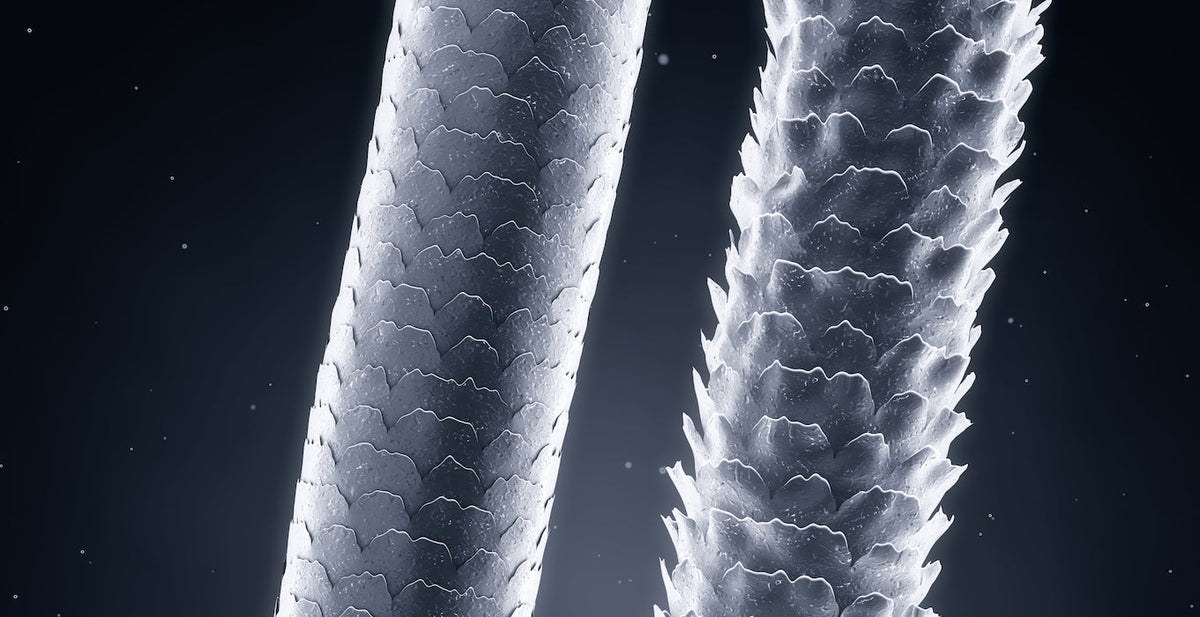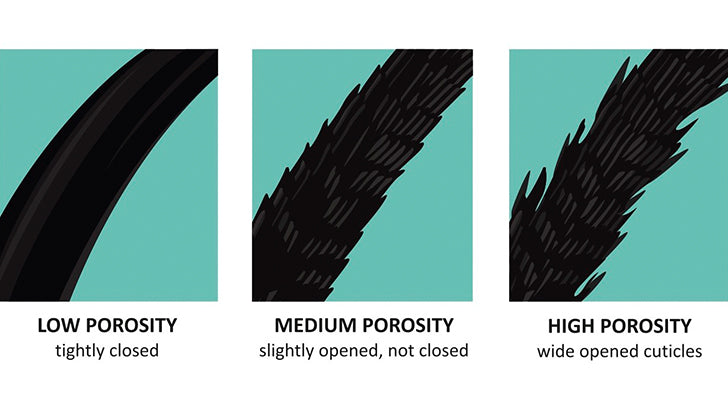
Hair porosity refers to the hair’s ability to absorb and retain water. There are 3 main types of hair porosity and your type is often dictated by your genetics, as well as how you treat it. Understand your hair porosity with our expert guide which showcases the different types, and how best to get the curls of your dreams.
Table of Contents:
- What is Hair Porosity?
- What Contributes to Hair Porosity?
- What Are The Different Porosity Types?
- What is My Hair Porosity?
- How to Test Hair Porosity
- Curly Hair & Porosity
What is Hair Porosity?
Hair porosity is the term used for your hair's ability to absorb and retain moisture. Hair porosity is determined by how open or closed the hair cuticles are. Hair cuticles are the little scales that cover the external layer of your hair’s surface. These scales control how much moisture can penetrate the hair shaft, and how hydrated your hair is.
Hair porosity can be split into three categories, which can influence how you care for your locks. The three different types of hair porosity are:
- Low porosity hair - This type of hair porosity has a very tight cuticle structure, which retains moisture well. This also makes it very hard for the moisture to penetrate through the cuticles when needed.
- Medium porosity hair - This hair porosity type has a looser cuticle structure. Meaning moisture can reach inside the hair shaft quite easily, but at the same time it is not lost too quickly.
- High porosity hair - Those with this hair porosity have a very open cuticle structure. Moisture can easily reach inside the hair shaft. However, it can flow out again just as quickly.
These scales can be more open or closed depending on a series of factors which include genetics, environmental agents, and hair damage.
What Contributes to Hair Porosity?

Genetics is the first element that factors into what type of hair porosity someone has. Depending on your genes, you can be born with naturally higher or lower porosity hair. Due to their dry nature, all curly hair types in their virgin state are naturally higher in porosity than straight hair. Therefore, the curlier a strand is, the higher porosity it tends to be.
However, hair porosity is not final. Porosity can change any time the hair structure is altered or damaged. The more damaged your hair is, the higher the porosity tends to be. This is because damage lifts the hair cuticles. There are several factors that can permanently affect hair porosity, some more drastically than others. These factors include:
- Excessive exposure to the sun, UVA and UVB rays
- Air pollution
- Dying your hair, whether air drying or diffusing
- Frequent use of heat styling (flat irons, hair curlers etc.)
- Bleaching your hair
If your hair has experienced any of these factors, your curls may require protein-rich products. Using a protein hair treatment could help to repair some of the damage done to your hair and help you achieve strong curls.
What Are The Different Porosity Types?
The American Board of Certified Hair Colorists categorizes porosity into 5 different levels:
- Grade 1 Porosity: Virgin hair that has been exposed to little or no environmental damage. This is very hard to find, and it’s more common in straight hair. The cuticles on this hair type are extremely tight, and they don’t allow moisture in or out. Those with this hair porosity often have shiny hair which looks smooth with no product on.
- Grade 2 Porosity: This is still natural virgin hair, but it’s been exposed to some type of environmental damage. This applies to most people with virgin hair. The hair is still very healthy and easy to manage. It doesn’t tangle too much and looks shiny. The cuticles are still very tight and it’s hard to make moisture penetrate into the hair shaft.
- Grade 3 Porosity: This is hair that’s been altered and colored up to 5 shades lighter. Since it’s been through some chemical processing, it has some level of damage. The cuticles are halfway open, they allow moisture in but they also start losing it more easily.
- Grade 4 Porosity: This is a hair porosity of tresses which have been bleached and lightened up to 7 shades lighter. This hair is quite compromised, as it’s been through a lot of chemical processing, so it will need additional care and attention. The cuticles in this hair porosity are open, so it needs lots of moisture because it also loses it very easily. This hair porosity type could benefit from using conditioners more often than usual. Knowing how to deep condition curly hair can help you make the most of your locks.
- Grade 5 Porosity: Hair porosity like this is too compromised to save. There is no cuticle left on the strands, you only see the inner part of the hair (called medulla). Because there is no structure left, the hair will feel gummy to the touch and break whenever you run your fingers through it. The only way to fix level 5 porosity hair is by cutting it.
Porosity grades are universally grouped in 3 categories: grade 1 and 2 are known as low porosity, grade 3 is known as medium porosity and grade 4 and 5 are known as high porosity.
The higher the porosity grade, the more protein-rich products you should incorporate in your routine. This helps to strengthen the cuticle structure and allows it to keep moisture inside the hair shaft. A product like our Bond Curl Rehab Salve can help to add protein to the hair and strengthen hair bonds.

What is My Hair Porosity?
There are several tests available to identify one’s hair porosity, but not all of them are as accurate.
The first is the glass of water test. Simply take a clean, product-free strand of loose hair and put it in a glass of water. If the hair floats at the top then it is low porosity, if it sinks slowly or settles in the middle it is medium/normal porosity, and if it sinks straight to the bottom then it is high porosity.
The other way to test is to simply run your fingers down a hair strand to feel its texture and hair porosity. If the hair feels smooth then it is low porosity, if it is rough or bumpy then it is high porosity.
How to Test Hair Porosity
The most effective test for hair porosity is without doubt the spray test. Make sure to start with clean, product-free hair - no leave-in conditioners or other styling products. Spray some water on a strand of hair and observe its behavior:
- If the water forms lots of little droplets on the hair surface without sinking in, you have low porosity hair.
- If the water forms some little droplets, but sinks in easily afterwards, you have medium porosity hair.
- If the water instantly sinks into the hair, you have high porosity hair.
Once you identify your hair porosity, you can determine which hair products you need to care for your locks.

Curly Hair & Porosity
Different porosities require different care, and making sure they get it is the secret to healthy, beautiful curls. It is possible to have different levels of porosity within your curly hair, especially if you are transitioning to natural hair.
You may find that your roots are low or medium porosity, whilst your ends that have seen straighteners, bleach and more may be high porosity. If this is the case you should always treat your hair for the highest level of porosity it has. This is because that's the area that requires more care and attention. Ideally, you should be looking to achieve and maintain the perfect protein moisture balance every wash day.
Why Choose Curlsmith?
We are a gourmet haircare brand that specializes in curls, from wavy, to coily hair. We created our range of curl-loving products in partnership with trichologists, curly hair stylists and curly influencers to bring you the best performing curly hair products on the market. Find all the product needed to serve the needs, suited to all curl types and textures